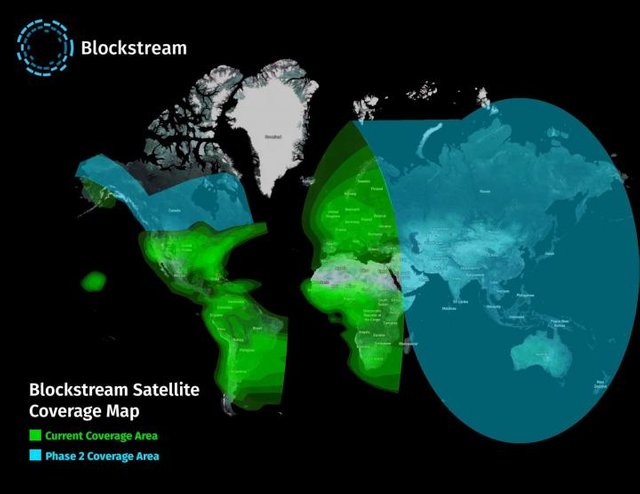Bitcoin ... The next generation hope, really?
Blockstream has just announced that the Bitcoin blockchain is now being broadcast from space. The new service, Blockstream Satellite, streams blocks down to much of the planet’s surface for free, in order to boost the connectivity, decentralization, redundancy, affordability, security, privacy, and ultimately adoption of Bitcoin.
“Blockstream Satellite enables further participation in Bitcoin,” states the company, “including the billions of people in the world without internet access and people in places where bandwidth prices make participating cost-prohibitive.
The service currently runs on three geosynchronous satellites positioned 22,000 miles above the Earth covering four continents, as well as several ground stations called teleports. Additional satellites will be added to the Blockstream Satellite network enabling worldwide coverage and reaching nearly every person on the planet by the end of 2017.
Self-described as “the leading provider of blockchain technologies,” Blockstream is the third-best funded startup in the Bitcoin space, behind Coinbase and Circle. Several of the current Bitcoin core team developers work at Blockstream, which provides a range of software and hardware solutions and expert professional services to companies deploying new blockchain-based networks.
The company's primary area of innovation is in sidechains, a technology invented to extend the capabilities of Bitcoin's blockchain. Sidechains create the opportunity for new models of trust, extending and improving upon the properties of Bitcoin.
Blockstream Satellite is the company’s newest innovation, “the world’s first public satellite service that allows anyone to operate and maintain Bitcoin nodes,” the company states, “without the constraints of traditional network connectivity.”
To launch the service, Blockstream leased capacity on existing, commercial, geosynchronous satellites already operating and orbiting, instead of launching their own, which keeps costs down. The satellites also host general purpose communications, including television, radio, and data.
These satellites are fed a data stream of the public Bitcoin blockchain from ground based stations called teleports, which run full Bitcoin nodes. The satellites then relay the broadcast back to earth using open source GNU Radio software and the Fast Internet Bitcoin Relay Engine (FIBRE), an open source protocol based on several years of experience operating and studying the Bitcoin Relay Network.
The system is currently designed to guarantee a 64kbit/sec connection. According to Blockstream CEO Dr. Adam Back, “This provides adequate bandwidth to reliably maintain synchronization with the network with modest delay.”
The size of the receiving dish also affects the download speed. “We designed the Blockstream Satellite system to work with a 46cm antenna to maximize the number of people around the world who will be able to use it,” the CEO explains. “But keep in mind this is the absolute minimum. Bigger antennas -- 60cm, 1.2m, or the VLA observatory antennas -- could result in faster speeds for users with future upgrades to the signals we transmit.”
Once users on the ground find a satellite dish, perhaps a used consumer satellite TV dish, they’ll need a USB software defined radio (SDR) interface, which Blockstream claims can be found for around US$100. “Ordinarily, end user satellite equipment is very expensive,” the company states, pointing out that their whole system was “uniquely designed to dramatically reduce this cost.”
Users can see details on what they need to get started in the website's documentation, including a list of equipment, how to point their antenna, and how to use the software. They can then run their own Bitcoin nodes using the service, or share Bitcoin nodes locally and configure their smart phone wallets to connect to their node.
Blockstream Satellite isn’t the first plan to put part of the Bitcoin network in space. Former Bitpay engineer and Bitcoin developer Jeff Garzik created a company and promoted his idea to build ‘BitSats’ between 2012 and 2015, before running out of funding and giving up on the concept.
Each Bitsat, which was proposed to be built and launched by Garzik’s company for the cost of around US$1 million each, was said to be able to be a backup copy of the blockchain in orbit that could verify incoming blocks and broadcast them around the world. Each had a five-year lifetime in low earth orbit and was prohibitively expensive.
Hi! I am a robot. I just upvoted you! I found similar content that readers might be interested in:
https://bravenewcoin.com/news/blockstream-satellite-broadcasting-the-bitcoin-blockchain-across-the-globe/
upvote
good
Congratulations @drjitesh! You have completed some achievement on Steemit and have been rewarded with new badge(s) :
Click on any badge to view your own Board of Honor on SteemitBoard.
For more information about SteemitBoard, click here
If you no longer want to receive notifications, reply to this comment with the word
STOPCongratulations @drjitesh! You received a personal award!
You can view your badges on your Steem Board and compare to others on the Steem Ranking
Vote for @Steemitboard as a witness to get one more award and increased upvotes!